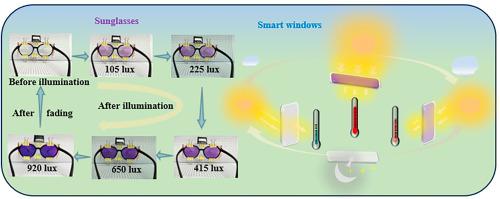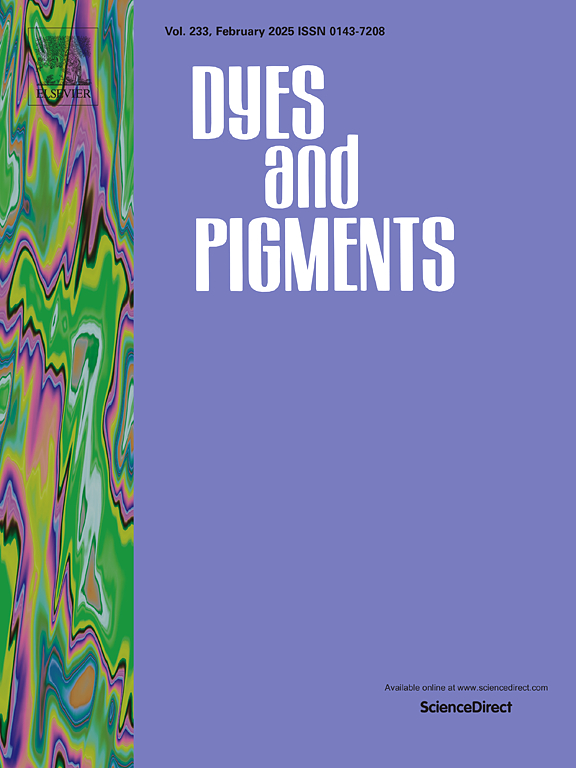Dynamic optical and thermal modulation of electrochromic smart windows and sunglasses based on benzothiadiazole-extended viologen derivatives
IF 4.2
3区 工程技术
Q2 CHEMISTRY, APPLIED
引用次数: 0
Abstract
Smart windows can regulate indoor lighting and heat intensity by isolating external light and heat, thereby achieving the goal of saving building energy consumption. However, traditional smart windows require additional power consumption to adjust color changes and thus regulate transmittance, and can only achieve relatively single control of light intensity and heat. Developing smart windows with dynamic photothermal modulation remains challenging. This paper reports two novel benzothiadiazole extended viologen derivatives DBTBB and DBTBH. The carboxymethylcellulose sodium hydrogel-state electrochromic devices based on DBTBB and DBTBH showed good electrochromic performance including a low operating voltage, a rapid response time, a high optical contrast, excellent cycling stability, and a large coloration efficiency. A dynamic photothermal modulation electrochromic smart window self-powered by a small commercial solar panel was constructed using the electrochromic hydrogel based on DBTBB, which could sense the changes in external irradiating light intensity and dynamically adjust the indoor light and heat without additional consumption of electricity, and the adjusting capability increased with the increase of irradiating light intensity. In addition, the application in smart color changing sunglasses self-powered by a solar panel was also investigated, the electrochromic sunglasses showed dynamic transmittance modulation in response to irradiating light intensities with good cycling stability, a gradual change in purple color from light to dark was observed as the irradiating light intensity increased from 105 → 225→415 → 650→920 lux. Moreover, both text and a colored logo were clearly displayed under different irradiating light intensities. This provides new methods for electrochromic applications in commercial settings and improving human quality of life, thereby creating new possibilities in the increasingly intelligent world.

基于苯并噻二唑扩展紫胶衍生物的电致变色智能窗户和太阳镜的动态光学和热调制技术
智能窗可以通过隔离外界光热来调节室内光照和热量强度,从而达到节约建筑能耗的目的。然而,传统的智能窗户需要消耗额外的电能来调节颜色变化,从而调节透光率,只能实现相对单一的光强和热量控制。开发具有动态光热调制功能的智能窗户仍然具有挑战性。本文报道了两种新型苯并噻二唑扩展紫胶衍生物 DBTBB 和 DBTBH。基于 DBTBB 和 DBTBH 的羧甲基纤维素钠水凝胶态电致变色器件显示出良好的电致变色性能,包括低工作电压、快速响应时间、高光学对比度、优异的循环稳定性和高着色效率。利用基于 DBTBB 的电致变色水凝胶构建了一种由小型商用太阳能电池板自供电的动态光热调制电致变色智能窗,它可以感知外部照射光强度的变化,动态调节室内的光和热,无需额外耗电,且调节能力随照射光强度的增加而增强。此外,还研究了由太阳能电池板自供电的智能变色太阳镜的应用,电致变色太阳镜显示出响应辐照光强度的动态透射率调制,具有良好的循环稳定性,当辐照光强度从 105→225→415→650→920 勒克斯增加时,观察到紫色从浅到深的渐变。此外,在不同的照射光强度下,文字和彩色徽标都能清晰显示。这为电致变色应用于商业环境和提高人类生活质量提供了新的方法,从而为日益智能化的世界创造了新的可能性。
本文章由计算机程序翻译,如有差异,请以英文原文为准。
求助全文
约1分钟内获得全文
求助全文
来源期刊

Dyes and Pigments
工程技术-材料科学:纺织
CiteScore
8.20
自引率
13.30%
发文量
933
审稿时长
33 days
期刊介绍:
Dyes and Pigments covers the scientific and technical aspects of the chemistry and physics of dyes, pigments and their intermediates. Emphasis is placed on the properties of the colouring matters themselves rather than on their applications or the system in which they may be applied.
Thus the journal accepts research and review papers on the synthesis of dyes, pigments and intermediates, their physical or chemical properties, e.g. spectroscopic, surface, solution or solid state characteristics, the physical aspects of their preparation, e.g. precipitation, nucleation and growth, crystal formation, liquid crystalline characteristics, their photochemical, ecological or biological properties and the relationship between colour and chemical constitution. However, papers are considered which deal with the more fundamental aspects of colourant application and of the interactions of colourants with substrates or media.
The journal will interest a wide variety of workers in a range of disciplines whose work involves dyes, pigments and their intermediates, and provides a platform for investigators with common interests but diverse fields of activity such as cosmetics, reprographics, dye and pigment synthesis, medical research, polymers, etc.
 求助内容:
求助内容: 应助结果提醒方式:
应助结果提醒方式:


